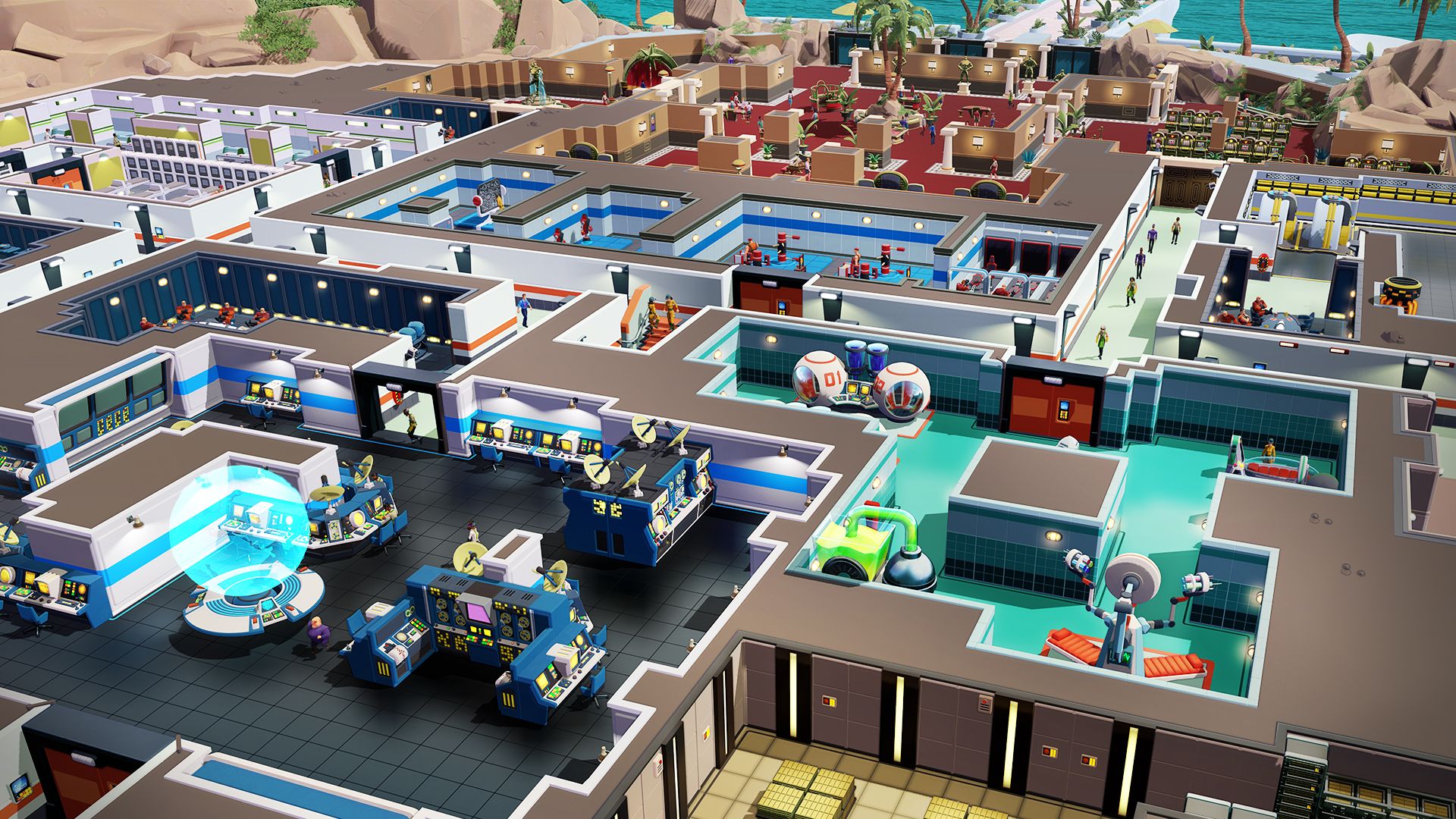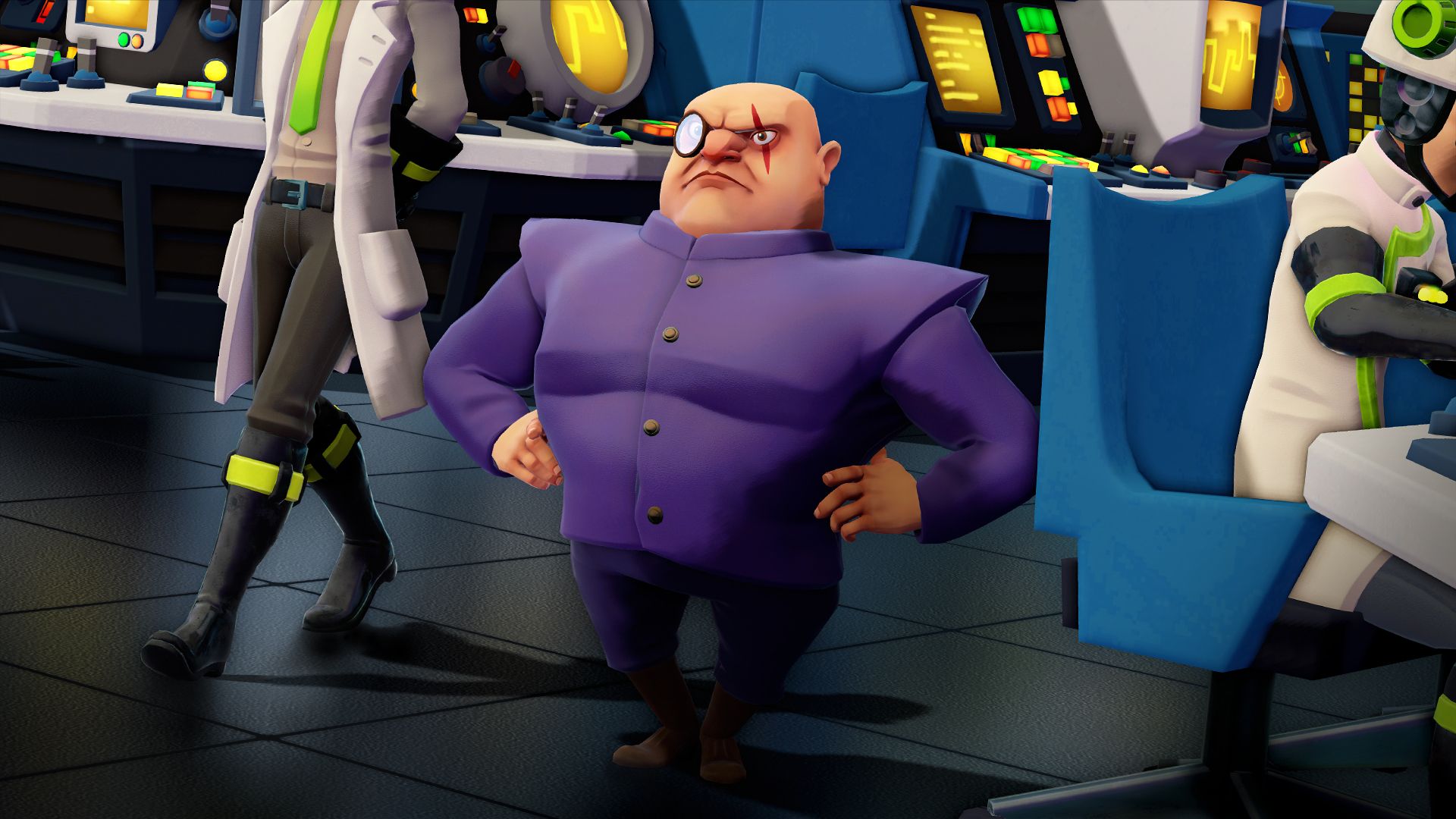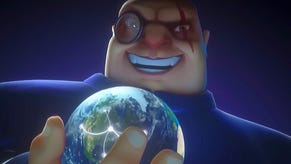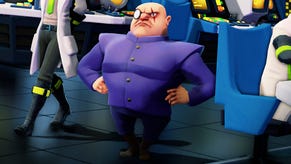Evil Genius 2 wants to feed the sharks, not jump them
To the Max
This is Maximilian. As you can see, he is a very insecure criminal mastermind. Not content with having a scar on his left eye, he wears a monocle on his right. He is trying very hard to be the stereotype of evil. When you need this many sinister affectations to intimidate your staff, you are probably broadcasting your own neuroses straight to the camera. But maybe this is to be expected of the lead evil-doer in Evil Genius 2: World Domination. After all, Max is basically the slime left behind when you pass multiple Bond villains through the parody mincer. Ash Tregay, producer on the game at Rebellion, seems to know this, even if he is determined to indulge in some moustache-twirling spin of his own.
“He is definitely not Blofeld or Dr Evil,” says Tregay, “because he doesn’t have a cat. Totally different man.”
It’s nice when developers are self-effacing, even if they have probably delivered the same gag to countless other journalists over the past 48 hours. I’m at E3, looking at a hands-off demo of the upcoming anti-spy management game. It’s a base-building manage ‘em up. You click and drag yourself a lair, building corridors here, a guard barracks there. We’re shown a “serum lab”, for instance, and a videogame room where your minions can go to unwind, presumably playing any game as long as it is published by Rebellion.
This all lurks beneath a cover operation - a front, basically. We’re shown a casino running on the tropical island above the lair. The casino is important, and you have to employ valets to convince people in the gambling halls there’s nothing to see behind those mysterious double doors.
“The cover operation is far more integrated in Evil Genius 2,” says Tregay, comparing it to the original Evil Genius of 2004. “It’s not the kind of thing you can ignore, it is your first line of defence against the Forces of Justice.”
Ah, the goodies. This isn’t just a game of minion management and judicious toilet placement, you see. It’s also a defence game of sorts, about keeping secret agents and brave commandos out of your lair. A tycoon of bad guy vigilance. The Forces of Justice are a handful of characters who want to get in and sabotage your lair. To stop them you have to combine traps as a sort of corridor defence. There are bouncy traps, carnivorous plants, big magnets, and giant bubbles like that one from The Prisoner. There’s pleasure in these toys, says Tregay, but also a reason why they are the tools of a cartoon villain.
“It’s to offer you the outlet of: you’re the bad guy, but you don’t need to feel bad about it,” he says, “because it’s ridiculous.”
You can spot goody-two-shoes agents by their behaviour. We’re shown one agent, dressed undercover in one of our minions’ outfits. But she can be spotted easily because she’s running (everyone else is ambling calmly) and wearing a non-uniform shoulder pad. But we soon see her blown down a corridor by a giant fan. She recovers and seems fine, until the floor opens beneath her and she plops helplessly into a shark tank.
“It is definitely a guilty pleasure, isn’t it?” says Ian Pestridge, the game's art lead who’s also sitting in on the demo. “It’s something everybody wants to do but they don’t want to admit to.”
There are moments, he says, when you watch an agent arrive at the island from a cruise ship, for example, and make their way through your casino.
“You almost want them to succeed,” he says. “Just to see what kind of mess you can make with your trap network.”
But there’s a bit of base-balancing to be done too. A twisting corridor of traps makes things hard for spies, but also cumbersome for your own minions. Making everything easy to reach improves efficiency, I'm told, but makes it easy for agents to get to your generator and blow it up. Exploding your facilities is one of the acts of sabotage the Force of Justice will do to stop you completing the “doomsday device” that will win you the game.
Rebellion are candid about their influences (you probably have to be when it’s based on such obvious parody-fuel as 1960s spy movies) and they talk with quiet respect for Two Point Hospital when showing off their underground lair (more on that in a bit). But most of the game’s attitude clearly comes from its 2004 ancestor. When they show off the prominent henchmen who patrol the corridors of your subterranean baddiebase, they highlight a character called Eli Barracuda Jr. He might be familiar to Evil Genius players, although the “junior” is notable.
“[He] looks remarkably similar,” says Pestridge, “but it is actually just his son”.
Red Ivan is another returning character, who you’ll be able to play as head villain this time, not just a form of muscle. You can control these characters directly, both henchfolk like Junior and your alpha geniuses like Ivan or the bemonocled Maximilian. So there is some direct “click-to-go-here” stuff going on. Although I’m told if your mastermind dies, it’s game over. Max is weak and slow, and should maybe stay away from infiltrating agents. But the strong Ivan can deal with spies himself. Or you could just throw agents in a brainwashing room and send them back to their HQ, convinced there’s nothing to report.
The developers zoom in on the lair and we see some other details. There are grunt minions battering punchbags to build muscle. There are security minions patrolling the hallways. Technician minions keeping machinery from bursting into flames. They all have some meters attached (health, energy, smarts). Basically, they’ll do their jobs for a while, then have to rest or do something recreative to recharge. But your underlings also have flaws. Or “traits” as Tregay puts it.
“The traits system was something we were interested to see in Two Point Hospital because we were already doing something similar, so it was sort of gratifying to see how well that was received. So we were like: ‘Oh cool, yeah, we are doing the right kind of thing, yeah!’”
They can be positive traits. But in the demo’s case we’re shown a minion sitting at a computer in the control room of our lair. He seems to be sleeping on the job. That’s the “lazy” trait. So head genius and grandmaster of neuroses Maximilian calls the minion over for a chat. We’re going to have a “HR conversation”, says Tregay. This mostly involves being hosed down with submachinegun bullets. The lazy minion puffs into a body bag, which is carted away by other, loyal minions. I get the feeling Max’s workforce is not unionised.
“We want to make sure when you do zoom in on those characters in those moments there’s some really good artwork to look at,” says Pestridge. “There’s moment-to-moment humour at looking at a guy falling asleep at his monitor, or watching the martial artists train themselves up… [they’re] not just numbers moving around.”
The demo is over, but I have time to ask the pair some questions. Before I leave, I ask why they wanted to make a sequel of this particular old game. The tycoon and management genres are fond of their throwbacks. But do we really need to revisit this stuff?
It isn’t about revisiting, says Pestridge. It’s more about capturing the “perceived memory” of the game - not the actual game itself. Because going back with a simple remake would not be enough in the case of Evil Genius. And to explain this in the most thematic way possible, he finds inspiration in the words of another villainous overlord.
“Sometimes reality can be very disappointing, as Thanos once said. The opportunity to re-imagine it as a sequel means you can recapture that nostalgia.”
Evil Genius 2 is due out some time in 2020
See our E3 2019 tag for more news, previews, opinions, and increasingly surreal liveblogs.












